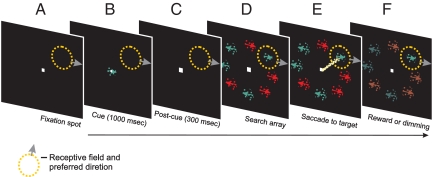Fig. 1.
Color/motion conjunction search task. The horizontal arrow along the bottom signifies passage of time within a trial. The following sequence occurred during each trial until either a fixation error occurred (trial aborted) or a saccade was made to a search item. A target-in-RF trial is shown. (A) Trials began with appearance of a centrally located white spot (0.2°), to which subjects were trained to fixate. The broken line represents a hypothetical RF; the arrow represents preferred direction. (B) After fixation was achieved, the cue appeared at the center of gaze for 1,000 ms. The cue consisted of a stationary circular aperture (1° of visual angle in diameter) within which moved a colored texture. (C) The cue was extinguished and the display contained only the fixation spot for additional 300 ms. (D) The search array appeared and remained on for the duration of the trial. The array contained eight stimuli, constructed similarly to the cue and distributed in a ring centered on the fixation spot. Ring eccentricity and stimulus diameter were optimized for each neuron. The search array was designed such that one item fell in the RF; that item moved in preferred or antipreferred direction. To obtain reward, the subject was required to search covertly (i.e., while maintaining central fixation) for the cued target. (E) Upon target identification, the subject was required to make an eye movement to its location and remain fixated at that location for 150 ms (white lines represent trace of eye position). (F) Correct choices yielded juice reward and darkening of search display. Incorrect trials concluded with brief dimming of nontargets before darkening of the display.

